去る5月8日、VE-Day、第二次世界大戦のヨーロッパにおける戦闘が終結してから75年が経過した・・・ある「ナチ党員」、への、手紙、から立ち上る、また一つの「悪の陳腐さthe Banality of Evil」/2020年5月アル・ジャジーラ
ある「ナチ党員」、への、手紙
Letters to A NAZI
1949年7月、48歳の一人の男性が、ローマ、ヴァチカンの病院で息を引き取った、死因は不明。数ヵ月前、男は、アルフレド・ラインハルト、なる偽名を用い始めた。
In July 1949, a 48-year-old man died of unknown causes in a Vatican hospital in Rome. A few months earlier, he had assumed a false identity, that of Alfredo Reinhardt.
この男の人生の最終の数か月は、ローマ郊外のある修道院で過ごされた。
T
he last months of his life had been spent in a monastery in a southern suburb of Rome.
しかし、この男がいったい誰であるのか、また、どのようにして、この地に落ちつくことになったのかは、およそ一千百万人の人びと、そこには、6百万のユダヤ人が含まれる、を虐殺した、ナチ支配下のヨーロッパの核心に迫る物語を提供することになった。
But the story of who he really was and how he ended up there is one that leads to the very heart of Nazi Europe and the slaughter of roughly 11 million people, including six million Jews.
法学教授にして弁護士のフェリペ・サンズが、その新著「縄梯子」の中で、明らかにしているように、この男の本名は、オットー・ヴァハターである。
As law professor and barrister, Philippe Sands reveals in his new book, The Ratline, the man's real name was Otto Wachter
オーストリア・ナチ党員として、彼は、ポーランド、クラカウの知事、続いて、今日のポーランド、ウクライナ国境にまたがる地域であるガリシア、の知事を歴任した。1939年と1945年の間に、彼の支配下にあるこの地域から、数万人のユダヤ人が、死地へ送られた。
An Austrian Nazi, he had held the position of governor of Krakow, in Poland, and then of Galicia, the region straddling the modern-day border of Poland and Ukraine. Between 1939 and 1945, hundreds of thousands of Jews from the regions under his control were sent to their deaths.
Krakow/Poland
Galicia
地図↓
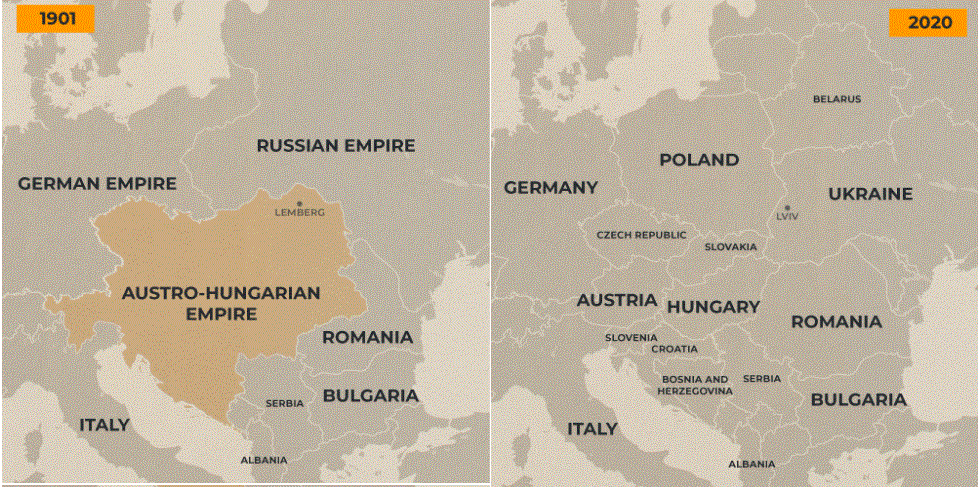
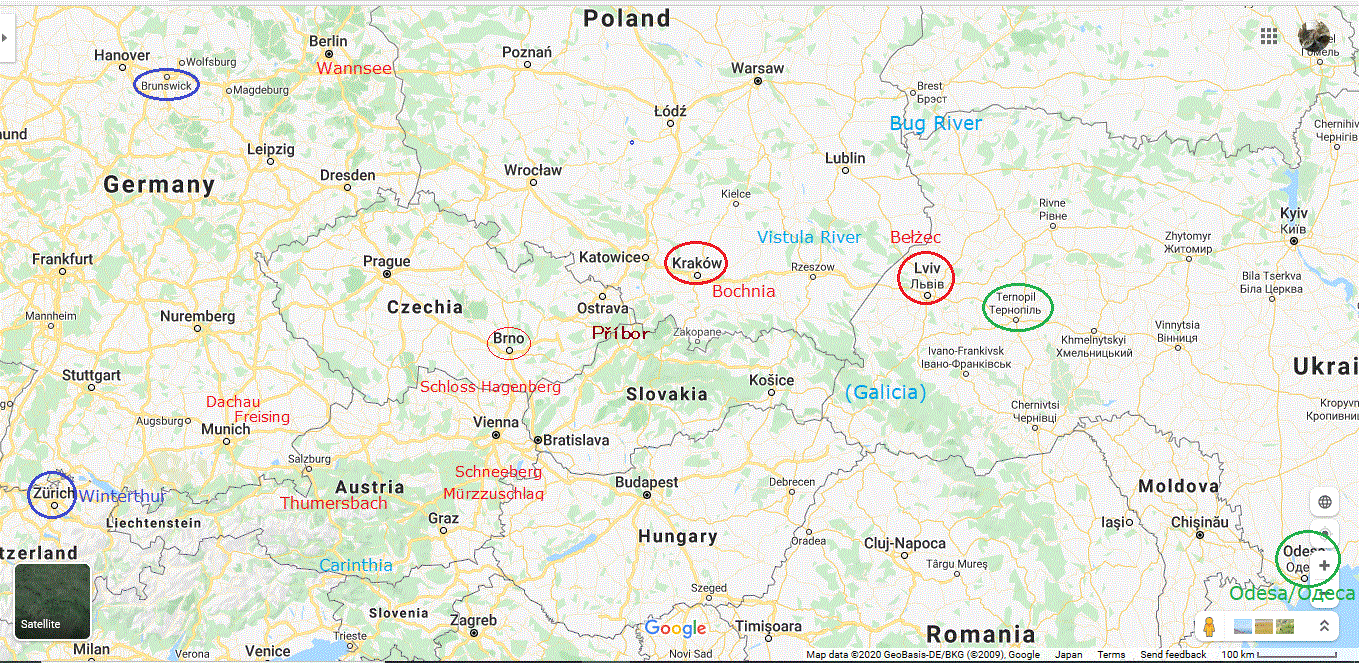
第二次世界大戦のヨーロッパにおける戦闘は、75年前に終了したが、哲学者ハンナ・アーレントの言葉を借りれば、「最も暗く深い奈落」の期間に、高位および中位のナチの責任者たちの大半が、裁きを逃れた。
World War II ended in Europe 75 years ago, but in the aftermath of what philosopher Hannah Arendt described as "the darkest and deepest abyss", the vast majority of senior and mid-level Nazi officials escaped justice.
オットー・ヴァハターはその一人である。彼は四年間の逃亡生活を送り、そのあらゆる段階で、外部からの援助を受けた。
Otto Wachter was one of them. He spent four years on the run, receiving help every step of the way.
「ラトリンratline(縄梯子)」という言葉は、これら責任者たちが、逮捕を免れて逃げのびるべく、ナチのシンパサイザーたちが、編み出した脱出路、の意味で用いられる。
The ratline was the term used for the escape routes devised by Nazi sympathisers for those fleeing capture.
その著書の中で、サンズは、一つの手掛かりを追っていく、それは最初はオーストリアに始まり、アルプスを越え、ドイツ、ポーランド、ウクライナを経て、最終的には、イタリアにたどり着いた。そこには、ヴァチカンや、アメリカ合衆国諜報部などの影も、見え隠れする。
In his book, Sands follows a trail that begins in Austria, passes through the Alps, Germany, Poland and Ukraine, before concluding in Italy. It is one that implicates the Vatican, the United States Counterintelligence Corps and others.
調査の過程で、彼は、文書庫を掘り起こし、ナチ党員の息子たちと会食し、アルプスに登った。そうまでしたのは、ある部分、オットーの物語が、彼自身の家族の物語と、交錯するものだったからだ。
During his research, he excavated archives, ate cake with the sons of Nazis and climbed the Alps. He did so, in part, because the story of Otto intersects with that of his own family.
サンズにとって、始まりは、2010年、ウクライナの都市、ルヴィヴに招かれて、人間性に対する罪、に関する講演を行ったときに遡る。
For Sands, it all began in 2010 when he was invited to deliver a lecture on crimes against humanity in Lviv, a city in Ukraine.
滞在中、彼は、彼自身の母方の祖父、レオン・バッハホルツの生家を発見した。1904年、バッハホルツの生まれた年だが、その町は、レムベルクと呼ばれていて、オーストリア・ハンガリー帝国の一つの州都であった。
While there, he found the house in which his maternal grandfather, Leon Buchholtz, had been born. In 1904, the year of Buchholtz's birth, the city was called Lemberg, and it was a regional capital of the Austro-Hungarian Empire.
Lviv
サンズは、彼の祖父の生い立ちについて、未知の部分を探りたいと思った、それを通じて、彼本人の来歴も、明らかになるだろうから。サンズの祖父は、戦争を生き延びたが、家族のほとんどは、殺された。
Sands hoped to fill in gaps in his understanding of his grandfather's identity and, by extension, his own. Although Sands's grandfather survived the war, almost every other member of his family was killed.
彼は、1939年から1945年、ドイツ占領下のポーランド総督であったハンス・フランクの生涯についての調査を開始した、この総督の下で、バッハホルツの家族は、絶滅させられたのだ。
He began to research the life of Hans Frank, the governor-general of German-occupied Poland between 1939 and 1945; the man under whose governorship Buchholtz's family was exterminated.
フランクは、人間性に対する罪によって起訴され、ニュルンベルクで絞首刑を受けた。
Frank was convicted of war crimes and crimes against humanity and hanged at Nuremberg.
調査の過程で、サンズは、フランクの息子、ニクラスと会見することになった。ほどなく、二人は、友情を取り結ぶようになった。
In the course of his research, Sands arranged to meet Frank's son, Niklas. In time, the two men became friends.
サンズによれば、ニクラスは、「自分の父を軽蔑していた」、という、あるとき、彼はこう言ったのだ、「私は死刑制度には反対だが、私の父に関してだけは、その例外になる。」
According to Sands, Niklas "despised his father", having once declared: "I am against the death penalty, except in the case of my father."
しかし、彼がサンズに紹介したもう一人のナチ党員の息子、オットーの息子、ホルスト・ヴァハターは、必ずしも、同様の考えの持ち主ではなかった。
But he introduced Sands to another son of a Nazi who did not feel the same way - Otto's son, Horst Wachter.
2012年の春、サンズは、オーストリアの北の国境に近い、シュロス・ハーゲンベルクに、12世紀に建てられたバロック風の城、それはすでに荒廃していたが、に住むホルストを訪れることになった。何年にもわたる手紙のやり取りの末、ホルストは、彼の家族の所有する膨大な文書庫を、サンズに見せる決断をしたのだ。
In the spring of 2012, Sands visited Horst in his dilapidated 12th-century baroque castle, Schloss Hagenberg, near Austria's northern border. Eventually, after years of correspondence, Horst decided to share his family's vast archive with Sands.
Schloss Hagenberg
その文書庫の中には、ホルストの母、シャルロッテ、と、父、オットー、との間で、1929年から、1949にかけて、取り交わされた、800通以上の手紙、シャルロッテの日記、および彼女が40年後に、二人の生活の回想をつづった文書、などが含まれている。
In it were more than 800 letters between Horst's mother, Charlotte, and his father, Otto, written between 1929 and 1949, as well as Charlotte's diaries and accounts of their life together that she wrote 40 years later.
これらを合わせて読めば、アドルフ・ヒトラーやハインリッヒ・ヒムラーを含む、きわめて高位のナチ党員と、かなり親しい間柄にあったこの夫婦、そのうちの男の方は、何万人に及ぶ男、女、子供の殺害に責任を有し、女の方は、夫と同じくらいに、ナチのイデオロギーを熱烈に信奉していた、その横顔が、鮮明に見えてくる、彼らは、ホロコーストの真っ只中にあって、芸術を、オペラを、自然を愛する家族であり、そして、第二次世界大戦の終結が近づくとともに、逮捕と訴追を、逃れるために、あらゆる努力を惜しまなかった家族であった。
Together, they paint a picture of a couple close to the most senior members of the Nazi party, among them Adolf Hitler and Heinrich Himmler; of a man responsible for the deaths of hundreds of thousands of men, women and children and a woman who embraced Nazi ideology just as fervently; of a family who enjoyed art, opera and nature in the midst of the Holocaust; and of a desperate bid to evade capture and justice as the second world war came to an end.
物語は、1929年、当時20歳のシャルロッテ・ブレックマン、裕福なオーストリアの鉄工所所有者の娘である、が、友人の誘いを受けて、週末のスキー旅行に出かけたときに遡る。
The story began in 1929 when 20-year-old Charlotte Bleckmann, the daughter of a wealthy Austrian steel mill owner, accepted an invitation to spend a weekend skiing with a friend.
シュネーベルクへの列車の中で、彼女は27歳のオーストリア人弁護士に出会う。
On the train to Schneeberg, she met a 27-year-old Austrian lawyer.
Schneeberg
その若き弁護士がオットーであった。オーストリア・ハンガリー帝国陸軍将校の息子で、ウィーン大学で法律を学び、在学中に政治活動を開始した。
The young lawyer was Otto . The son of an officer in the imperial Austro-Hungarian Army, he had studied law at the University of Vienna, where he became politically active.
初期のヒトラーの信奉者の一人として、彼は、「反ユダヤ主義同盟」という団体の組織した、1921年、ウィーンの、大規模なユダヤ人排斥運動に参加する。このとき逮捕、裁判を受けて14日間収監された。1923年4月1日、ナチ党の党員となる。
An early supporter of Hitler, he had taken part in a large anti-Jewish protest organised by an organisation called the Antisemitenbund in central Vienna in 1921. He had been arrested and tried and spent 14 days in prison. On April 1, 1923, he had become a member of the Nazi party.
婚約期間中、シャルロッテとオットーは、公園を長い時間をかけて散歩したり、ボートに乗ったりした。
During their courtship, Charlotte and Otto took long walks in the park and went boating.
1931年の3月、シャルロッテは、オットーに、ヒトラーの「わが闘争」を一冊、贈呈した。
In March 1931, Charlotte gave Otto a copy of Hitler's Mein Kampf.
「最後まで、戦いと愛を通して」
―これが、シャルロッテが、「わが闘争」の表紙の裏に、書き添えたオットーへのメッセージだった。
"Through struggle and love to the end."
- A message from Charlotte to Otto written on the flyleaf of Mein Kampf.
その年の5月、彼女はナチ党の党員となる。ほどなくオットーは、ナチ党のウィーン地区主任となる。そして、1932年4月、彼は親衛隊(SS)に参加する。
In May of that year, she became a member of the Nazi party. Soon, Otto became district chief of the Nazi party in Vienna. Then, in April 1932, he joined the SS.
しかし、シャルロッテの日記には、彼の政治的活動について触れるところは、少ない。
But Charlotte's diary rarely made reference to his political activities.
二人は、1932年11月に結婚、シャルロッテは、当時すでに妊娠していた。
They married on September 11, 1932. Charlotte was pregnant at the time.
1933年3月5日、ナチ党は、ドイツ連邦選挙で勝利。わずか二週間後、ヒトラーは、専制権力を掌握する。
On March 5, 1933, the Nazis won the German federal elections. A little over two weeks later, Hitler gave himself absolute power.
シャルロッテとオットーの最初の子供、オットー・ジュニアが生まれたのは、その数日後、4月2日のことであった。彼らの間には、全部で6人の子供ができた。
Charlotte and Otto's first child, Otto junior, was born a few days later, on April 2. They would have six in total.
翌年、1934年の7月25日、オーストリア・ナチは、彼自身ファシストではあるが、ヒトラーよりはむしろイタリアのムッソリーニとより深い友好関係を保っていた、エンゲルベルト・ドルフュスの政府を打倒しようとした。彼は、ヒトラーが熱望していた「アンシュルスAnschluss」と呼ばれるオーストリア併合に対しては、反対の立場で、したがって、オーストリアにおけるナチ党を禁止していた。
The following year, on July 25, 1934, Austrian Nazis attempted to overthrow the government of Engelbert Dollfuss, himself a fascist but one more closely aligned with Italy's Benito Mussolini than Hitler. He opposed the annexation (or Anschluss) of Austria that Hitler so desired and had banned the Nazi party in Austria.
クーデターは未遂に終わったが、ドルフュスは殺害された。
The attempted coup failed, but Dollfuss was killed.
13名のナチ党員が逮捕され、裁判を受け、ウィーンの街頭で絞首刑にされた。
Thirteen Nazis were arrested, tried and hanged in the streets of Vienna.
この事件に関する、オットーの関与については、正確なところは、わからない。しかし、彼は、オーストリア国家から、国家反逆罪として訴追を受けた。彼は、逮捕される前に、ウィーンを脱出した。
Otto's exact involvement in the plot was never clear. But he was indicted by the Austrian state for high treason. He fled Vienna before he could be arrested.
数日間連絡が途絶えていたが、やがてシャルロッテは、オットーが、ベルリンに匿われていることを知る。
After several days with no news of him, Charlotte learned that Otto had found refuge in Berlin.
ドイツで、彼は兵役を終え、法律の実務家としての資格を得、親衛隊内部で、急速に昇進し始めた。
In Germany, Otto completed his military service, qualified to practice law there and rose quickly through the ranks of the SS.
オーストリアでは、シャルロッテは、まだ赤ん坊の息子を伴って、故郷のムルツシュラックに戻り、来客の訪問を受けたり、チェスをしたりの日々を送っていた。
Back in Austria, Charlotte returned to her hometown of Murrzzuschlag with their baby son, where she received visitors and played chess.
Murzzuschlag
1935年9月、ニュルンベルク法が、「ライヒスタークReichstag」と呼ばれるドイツ国会を通過。この法律により、ユダヤ人からはドイツ市民権が剥奪され、ユダヤ人と非ユダヤ人の間の婚姻が禁止され、こうしてドイツにおける、組織的なユダヤ人弾圧の法的枠組みが整った。
In September 1935, the Nuremberg Laws were passed by the German Parliament, the Reichstag. They stripped Jews of German citizenship and banned marriage between Jews and non-Jewish Germans, providing the legal framework for the systematic persecution of Jews in Germany.
1936年秋、二年ぶりの再会として、シャルロッテはオーストリアからドイツへ車を運転し、フライシングの兵営に、オットーを迎えに行き、ベルリンに送り届けた、その兵営でオットーは、ダッハウの収容所における兵役を終えようとしていたのである。ダッハウは、ナチによって建設された最初の収容所であるが、当初は、政治犯のための収容施設であった。
In the autumn of 1936, after two years apart, Charlotte drove from Austria to Germany, collecting Otto from the barracks at Freising where he was completing his military service at the Dachau concentration camp, before driving him to Berlin. Dachau, the first concentration camp created by the Nazis, was initially a camp for political prisoners.
Freising
Dachau
ベルリンでは、オットーは、SDと呼ばれる、親衛隊の諜報部門の仕事に充てられた。
In Berlin, Otto was offered a job in the SD, the intelligence agency of the SS.
当時、1937年の初めごろ、彼は、「親衛隊中佐SS-Obersturmbannfuhrer」に昇進、彼の個人ファイルには、「率直で腹蔵のない」性格、教育程度の高い、常識を弁えた、何より、完璧な「人種的特徴」、すなわち、「背が高く、細く、北方系の顔立ち」をそなえている、と記されている。
When, in early 1937, he was promoted to SS-Obersturmbannfuhrer, his personnel file described him as having an "upright and open" character, of being well-educated, with common sense, and perfect "racial characteristics", namely "tall, slender, with Nordic appearance".
しかし、シャルロッテとオットーの結婚生活にとっては、そうよいことばかりではなかった。シャルロッテは、オットーが浮気をしていることを嗅ぎつけた。シャルロッテは当時妊娠中であったが、それを中絶した。
But things were not progressing so well in Charlotte and Otto's marriage. Charlotte learned that Otto had had an affair. It was not his first. Charlotte was pregnant at the time and responded by terminating the pregnancy.
1938年1月、親衛隊の指導者であるハインリヒ・ヒムラーは、オットーを「親衛隊大佐SS-Standartenfuhrer」に昇進させた。
In January 1938, Heinrich Himmler, the leader of the SS, promoted Otto to SS-Standartenfuhrer.
しかし、オーストリアにおける事態の推移が、ヴァハター夫妻をして、ベルリンにとどまり続けることを許さなかった。
But developments in Austria meant the Wachters would not stay in Berlin for long.
1938年3月11日、オットーの友人であるアルチュール・セイス・インクァルトが、オーストリア知事となった。その翌朝、ドイツ軍が国境を越えて侵入。併合は完了した。
On March 11, 1938, Otto's friend Arthur Seyss-Inquart became governor of Austria. The following morning, German troops marched across the border. The annexation was complete.
四十年後、シャルロッテは、この「たった一つの出来事が、すべてを変えた」ありさまを記述している、「それは、私たちのもっとも激しい希望であり、決して実現することはないと思っていたのだが、唐突に現実のものとなったのだ」と。
Forty years later, Charlotte described how this "single event changed everything, and our wildest dreams, which we never imagined could be realised, suddenly came true."
「ナチ党員は一人残らずこの奇蹟に狂喜し、お互いを抱きしめあった。そう、それは、私たちの人生の中で、もっとも決定的な瞬間の一つであった、とりわけ、ドイツに逃れ、そこで『違法外国人』として暮らすことを余儀なくされていた何十万もの人びとにとっては」
シャルロッテの回想録、1938年3月11日
"Every Nazi felt such joy about this miracle, we all embraced each other. Yes, it was one of the most decisive moments of our lives, and in those of the hundreds of thousands who had fled to Germany and were living as ‘illegals'."
- Charlotte's account of March 11, 1938.
シャルロッテとオットーは、ウィーンに戻り、ヒトラーの到着を迎えることになる。
Charlotte and Otto returned to Vienna in time to witness Hitler's arrival.
「私たちは、巨大なメルセデスに乗って町に出て行き、私たちのために取っておかれた場所と、友人たちの姿を探した。フィッシュボックス、レールスなど、みんなそこにいた。突然、遠く離れた場所から、叫び声が聞こえてきた、やがてそれは、圧倒的な歓喜の叫び、『ハイル・ヒトラー』に変容していった。押し寄せる人の海の如く、それは近づくにつれ次第に大きくなってきた。ヘルデンプラッツへの道路は、いっぱいだった、人は肩と肩を触れ合わせて立っていた、ラトハウスまで、バルハウスプラッツの近くまで。道をあけるのには、たいそうな手間と時間がかかった。総統は、手を挙げて立っておられた、興奮のあまり叫んでいる群衆に祝福を与えながら、・・・、それは自発的な、衷心からの喜びの発露であった。誰もが、この心の底からの歓喜の感覚を、携えていた。」
シャルロッテの回想録、ヒトラーのウィーン到着
"We went into town in the big Mercedes and looked for our friends and the place we'd been assigned. The Fischbocks, the Lehrs and others were all there. Suddenly we heard a loud cry in the distance, which turned into an overwhelming cry of joy, ‘Heil Hitler'. It approached like a surging human sea, getting closer and louder. The road to the Heldenplatz was completely full, people standing shoulder to shoulder, all the way up to the Rathaus, around the Ballhausplatz. It took a lot of time and effort to clear the route. The Fuhrer was standing with a raised hand, greeting the crowd, which was shouting excitedly … a spontaneous and heartfelt outburst of joy. Everyone was carried along in this feeling of heartfelt joy."
- Charlotte's account of Hitler's arrival in Vienna.
オットーとシャルロッテは、ヘルデンプラッツのバルコニーに席を占めた。シャルロッテにとって、ヒトラーと共に過ごすのは、「わが人生最良の瞬間」であった。
Otto and Charlotte had secured seats on the balcony of the Heldenplatz. For Charlotte, that time with Hitler was "the best moment of my life".
Heldenplatz
Rathaus
Ballhausplatz
以下のウィーンの地図↓は、グレアム・グリーン「第三の男」、ジョン・アーヴィング「ホテル・ニューハンプシャー」、リリアン・ヘルマン「ジュリア」、のために作ったもの。「第三の男」は、第二次世界大戦直後、ウィーン市が、連合国四か国共同統治下にあった時代を舞台としている。「ジュリア」には、ジークムント・フロイトの下で、ウィーン大学医学部で精神分析を学んでいたジュリアが、大学構内でナチ学生部隊の襲撃を受けるシーンがある、フロイト自身は、すでにロンドンに脱出していたかも知れない、ジュリア自身は「ユダヤ人」ではないようだがが、後に彼女の所属するレジスタンス組織に、資金を届けに行くという危険な任務を、「ユダヤ人」であるリリアン・ヘルマン、その人とおぼしき、「私」、が担うことになる。「ホテル・ニューハンプシャー」には、視力を失ったものの収容所から生還した、その名も「フロイト」なるあだ名を持つ登場人物の一人のユダヤ人が、この1938年のウィーンの情景を回顧する場面がある。あの映画のロケは、カフェ・モーツァルトで行われたんだ、という台詞によって、「第三の男」への言及もある。
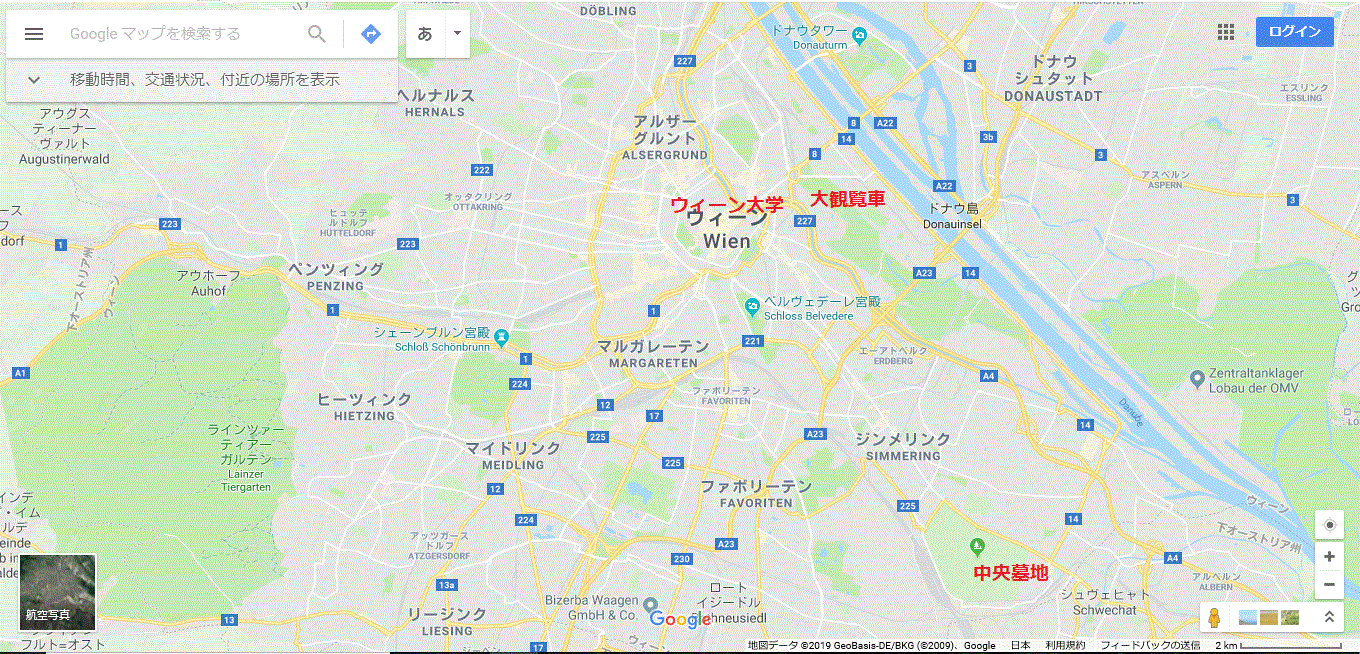
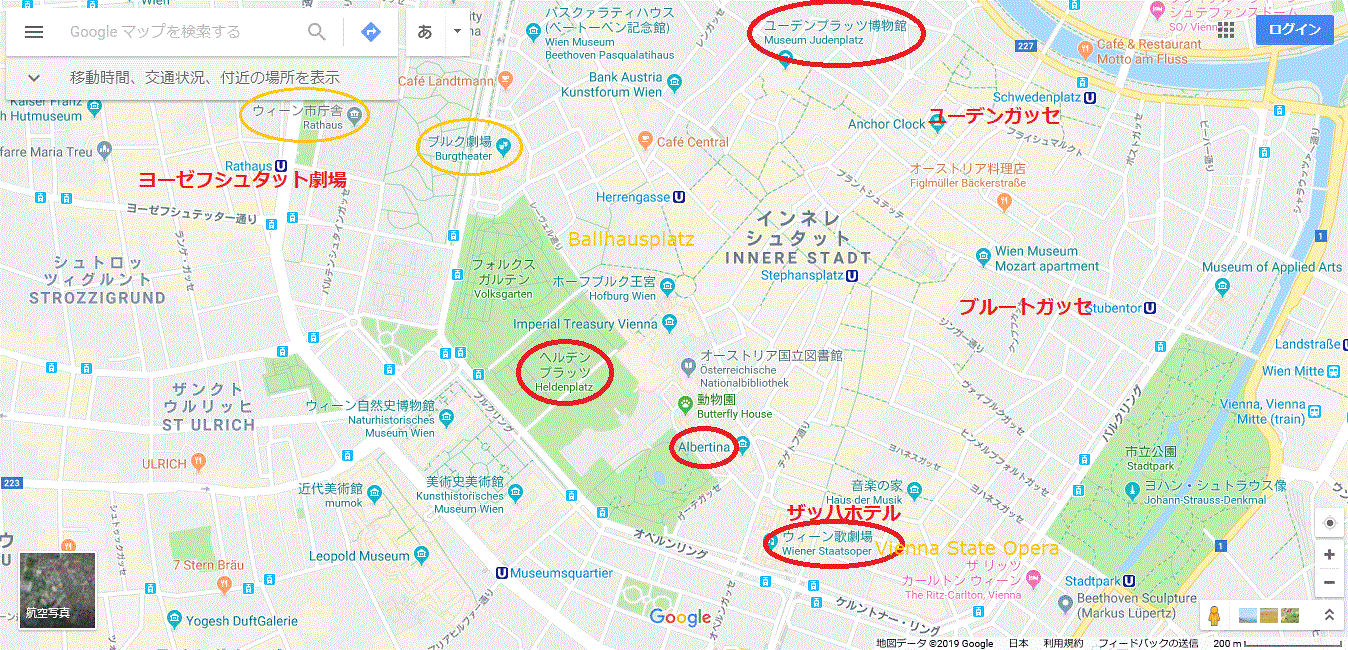
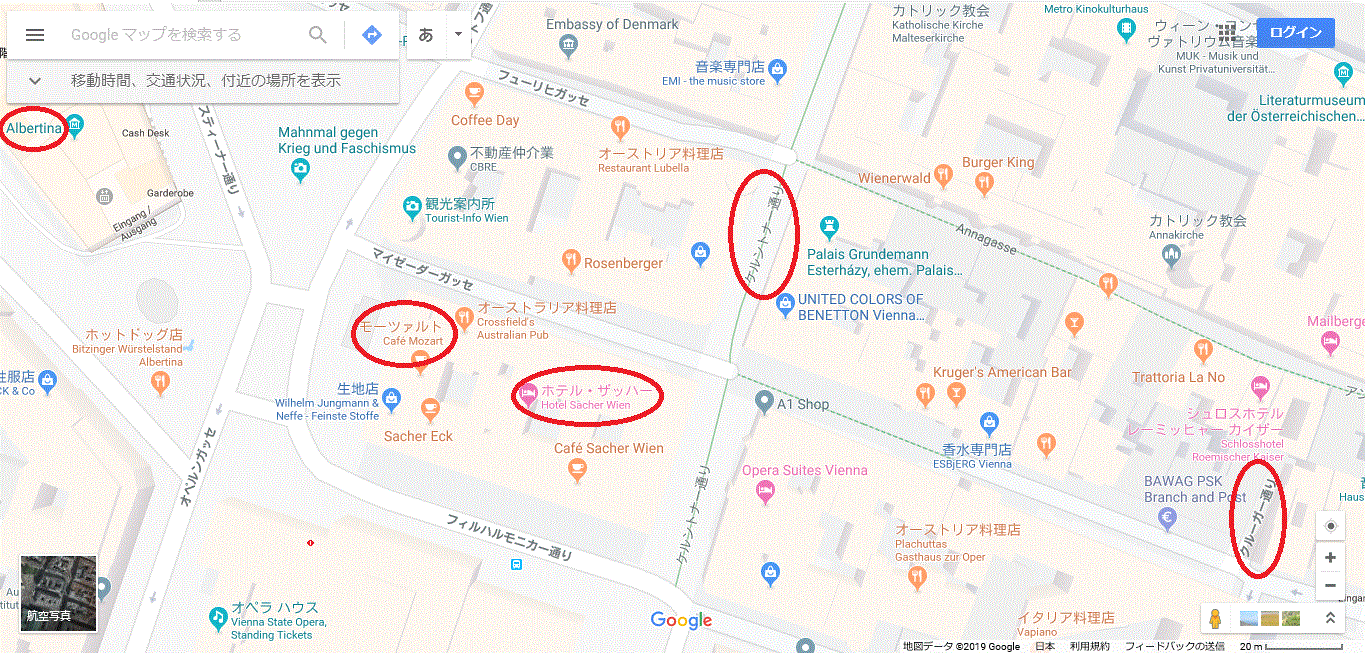
まもなく、オットーは、州長官の地位に充てられた。
Shortly afterwards, Otto was offered a position as state commissioner.
「オーストリア知事、アルチュール・セイス・インクァルト博士は、1934年7月のナチによるクーデター未遂の組織者である、オットー・ヴァハター博士を、州長官の任務に就けた」
ニューヨーク・タイムズの報道による
"Dr Arthur Seyss-Inquart, Governor of Austria, has appointed an organizer of the Nazi Putsch of July 1934, Dr Otto Waechter, to be State Commissioner for matters of personnel."
- A New York Times report.
「アンシュルス」、すなわち「オーストリア併合」、から一週間を経ないうちに、新憲法の条項によって、公共機関の変更が認められた。オーストリア民政の機構改革に関する条例第三条によって、すべてのユダヤ人、および「ミシュリンクMischlinge」と呼ばれた部分的ユダヤ人は、自動的に排斥されることになった。
Within a week of the Anschluss, a new constitutional provision allowed for the reform of public bodies. According to Section 3 of the ordinance restructuring the Austrian civil service, all Jews and part Jews (Mischlinge) would be automatically dismissed.
Mischlinge
元来は、スペイン語の「メスティーソmestizo」のように「混血」を意味する言葉であったが、ナチス・ドイツでは、アーリア人とユダヤ人とを祖先に持つ者、と限定的に用いられた、とのこと
オットーは、この、オーストリアの公務員から、(ユダヤ人を排斥して)「浄化する」という仕事に、異常な情熱を持って臨み、それは、かつての師であるところの、ウィーン大学の法学部教授たちを退職に追い込むことも躊躇しないほどだった。この間に、彼は、少なくとも16237名の公務員を解雇し、その多くは収容所へ送られた。
Otto set about his task of cleansing the Austrian civil service with ruthless vigour, even dismissing some former law professors at the University of Vienna. In time, he dismissed at least 16,237 civil servants, many of whom were transported to concentration camps.
1938年11月9日、「クリシュタール・ナハト/打ち壊されたガラスの夜」、シャルロッテは、ウィーンのブルク劇場で、新作劇「クロムウェル」の初日の公演を観ていた。彼女の観劇中、劇場の外のウィーンの街路では、ユダヤ人の住居、商店、ジナゴーグが、焼き討ちにあい、破壊されていたのだ。
On November 9, 1938 - Kristallnacht (the Night of Broken Glass) - Charlotte attended the premiere of a new play, Cromwell at the Burgtheater in Vienna. While she watched the play, on the streets of Vienna, Jewish homes, shops and synagogues were ransacked, burned and destroyed.
Burgtheater
その虐殺によって、27人のオーストリア系ユダヤ人が殺害された。約六千人が逮捕され、強制退去させられた、ほとんどすべてが、ダッハウの収容所へ送られた。
Twenty-seven Austrian Jews were murdered during the pogrom. About 6,000 were arrested and deported - almost all of them to Dachau.
しかし、シャルロッテの日記には、これらの事件に関する言及は、何もない。
But Charlotte made no mention of those events in her diary.
この時期のシャルロッテをめぐる個人的なドラマとしては、オットーのもう一つ別の浮気が発覚したことがあった。しかし、彼女は、ウィーンの文化シーンに耽溺し、フルトベングラー指揮のモーツァルトやベートーベンのコンサート、ヨハン・シュトラウス作のオペレッタ「こうもり」を観たりしている。大みそかには、ウィーンの恒例の「オペラ・ボール」に出席している。
Charlotte's own private drama during this time revolved around her discovery that Otto had had another affair. Still, she immersed herself in Vienna's cultural delights, attending a concert of Mozart and Beethoven conducted by Furtwangler and a performance of Die Fledermaus by Johan Strauss. She spent New Year's Eve at Vienna's annual Opera Ball.
Wilhelm Furtwangler(1886-1954)
上の↑wikipedia記事によれば、この高名な指揮者は、必ずしもナチ政権に同調的ではなかったようである。1933年、ブルーノ・ワルターBruno Walter(1876-1962)が、ナチ政権から、ユダヤ人であるとの理由で、ライプチッヒ・ゲバントハウス・オーケストラを解雇されると、その後任となることを要請されたが、拒否した、との逸話が書かれている。
Opera Ball、ウィーン歌劇場Vienna State Operaで、「聖灰水曜日」直前の木曜日に、開催される舞踏会。「聖灰水曜日Ash Wednesday」は「イースター」に先行する「Lent」の六週間の初日、「イースター」は、「春分後初の満月後の最初の日曜日」で、グレゴリオ暦上、3月下旬から、4月に当たることになるから、確かに、一月頃にはなるが、あるいは、別のイベント、Wiener Musikvereinウィーン楽友協会、歌劇場の南東300mあたり、で開催される「Vienna New Year's Concert/Neujahrskonzert der Wiener Philharmoniker」と混同されているかも知れない。
1939年の「月齢付きカレンダー」を調べると、この年の春分後の最初の満月は、4月5日水曜日であるから、「イースターの日曜日」は4月8日、その六週間前は2月25日となる。ちなみに、ベルトルト・ブレヒト「イースター・サンデー」は、すでにデンマークのスヴェンボルクに亡命していた彼が、その日に、ヒトラーの不吉な布告について耳にする、という内容だが、この年のことを描いているのでは、と思っているが、そのヒトラーの布告がなにをさすのかについては、突き止められていない。
月齢付きカレンダー(1939年)
Svendborg/Denmark
いや、記憶違いだ、ブレヒトの歌は、「イースター・サンデー1935」だった。
Bertolt Brecht Easter Sunday 1935/Dagmar Krause
「そうしてうちに帰り、たった一人で、真夜中を待った」と彼女は記している。
"Afterwards home and waited for midnight alone," she recorded.
「実に素晴らしい年であった、私たちの生命に、巨大な変革をもたらしたのだから、・・・、私たちは今や偉大な国民である、私たちは総統を戴いているのだから。」
シャルロッテの日記、1938年大晦日
"[It was a] glamorous year which brought big changes to our lives! . . . We are now a big country, and we have the Fuhrer."
- Charlotte's diary entry from New Year's Eve, 1938
1939年9月1日、ナチはポーランドに侵攻した。
On the morning of September 1, 1939, the Nazis invaded Poland.
二日後、英仏両国は、ドイツに対して宣戦布告した。
Two days later, on September 3, Britain and France declared war on Germany.
9月29日、ドイツとソヴィエト連邦は、ポーランドを分割、ブク川の西側をドイツが、東側をソ連が。
On September 29, Germany and the Soviet Union divided Poland between them - the Germans taking everything west of the Bug River and the Soviets everything to the east of it.
Bug River、現在のポーランド、ベラルス国境を画している河のようである
同年10月8日、ヒトラーは、ポーランドの多くの部分を併合。
On October 8, Hitler annexed large parts of western Poland.
数日後、ヒトラーは、ハンス・フランクを、ドイツ占領下の、直接的に併合されていなかったポーランド部分の総督に任命。フランクは、その住居および司令部をワーウェル城に定めた。オットーの親友であるアルチュール・セイス・インクァルトは、その副官に任命された。
A few days later, Hitler declared Hans Frank the governor-general of German-occupied Poland - those parts that had not been directly annexed. Frank set up his residence and headquarters at Wawel castle. Otto's close friend, Arthur Seyss-Inquart, was appointed as his deputy.
Wawel castle、Krakow市内にある
1939年10月17日、オットーは、ポーランドの四地区のうちの一つ、クラカウ地区の主任行政官となった。しかし一月経ないうちに、セイス・インクァルトが別の地位に移ったので、オットーはその後任として、クラカウ知事となった。オットーは事務所を、クラカウの中心部の広場に面した、ポトチ宮殿に定めた。
On October 17, 1939, Otto became chief administrator for the District of Krakow, one of the four new districts of Poland. But within a month, Seyss-Inquart was moved to another position and Otto was appointed governor of Krakow. Otto established his office in the Potocki Palace, on Krakow's main square.
クラカウ中心部にPotocki Palaceは見つからない。「Palac Potockich w Krzeszowicach」は、クラカウ西北西15kmばかり。のちの任地である現ウクライナLvivルヴィヴに、同名の宮殿があるから、記者の混同によるのかも知れない。
Palac Potockich w Krzeszowicach
Potocki Palace/Lviv/Ukraine
シャルロッテと子供たち、今や四人、は、ウィーンに残った。
Charlotte and the children - they now had four - remained in Vienna.
「オットーはめったに家にいない」、とシャルロッテは記している、しかし、手紙はしばしばくれた、とも。
"Otto came home rarely," Charlotte noted, but he wrote often.
シャルロッテは、自分の夫の新任の仕事を、「人間味にあふれ、同情的な」権力行使である、と称賛している。
Charlotte rejoiced in her husband's new work, and the "humane and sympathetic" way he exercised power.
「彼は無実の人びとを射殺することを拒否した、・・・、彼はいつも言っていた、『人民を理解し、愛を持って統治しなければならない』と。」
戦後40年に記された、シャルロッテの記述
"He refused to shoot innocent people… He would always say: ‘You have to try to understand the people and govern with love.'"
- Charlotte's account, recorded 40 years after the war.
1939年11月11日、知事として執務した最初の日に、オットーは、「クラカウ地区内のユダヤ人に印をつけることについて」なる表題の命令書に署名した。その命令は、12歳以上のすべてのユダヤ人に対して、正確に10cm幅の、白地に、青くダヴィデの星が描かれた腕章を、身につけることを要求している。その義務を怠ったものには、「厳重な処罰」が課されることも明記されてあった。
On his first day as governor on November 11, 1939, Otto signed an order with the title, Marking of Jews in the District of Krakow. It required Jews over the age of 12 to wear a blue Star of David on a white armband, precisely 10cm (four inches) wide. Those who failed to comply faced "severe punishment".
「明日、私は、50人のポーランド人を、公開銃殺刑に処さなければならない。」
オットーからシャルロッテに充てられた1939年11月の手紙、妻が彼を訪ねてクラカウに来るにはふさわしくない日であることの理由として述べている
"Tomorrow, I have to have 50 Poles publicly shot."
- Otto's letter to Charlotte in November 1939, explaining why it was not a good time for her to visit him in Krakow.
これらの者たちを銃殺せよとの命令はベルリンから来た。それは、二人のドイツ人警官が殺害された、警察署襲撃事件への報復であった。その首謀者としてポーランド人地下組織「ホワイト・イーグル」所属の二人の者が、補足され、街灯から吊るされて殺された。
The order to shoot the men had come from Berlin. It was a reprisal for an attack on a police station, in which two German police officers had been killed. The two perpetrators, members of a Polish underground organisation called White Eagle, had been caught and hanged from street lamps.
ドイツ占領下のポーランド人地下組織に、「ホワイト・イーグル」という名称のものは見つけられなかった。wikipedia英語版の以下の記事↓によると、1939年11月9日「秘密ポーランド軍Secret Polish Army」が創設された、とのこと。「ホワイト・イーグル」、「白い鷹」は、ポーランド軍の徽章として用いられているようである。
1939年12月18日、約50人の者たちが、クラカウ近郊のボヒニアで検挙され、雪の原野を歩かされた後、射殺され、地元のユダヤ人の強制労働によって掘られた穴に、埋められた。オットーがその大量処刑の現場にいた、との証言がある。
On December 18, 1939, about 50 men from Bochnia, near Krakow were rounded up, led across a snow-covered field and shot, before being buried in a mass grave that local Jews had been forced to dig. According to witness accounts, Otto attended the mass execution.
Bochnia
ドイツ軍は、戦勝に戦勝を重ねていた。「オランダが降伏した」、シャルロッテは1940年5月15日の日記に記している。その三日後、「ブリュッセル陥落」。そして、6月23日、「フランスとの講和条約が昨日、署名された」、フランスの降伏である。
Germany was winning more and more ground. "Holland capitulates," Charlotte wrote in her diary on May 15, 1940. Three days later, "Brussels falls". And on June 23, "France peace agreement signed yesterday" - a reference to France's surrender.
シャルロッテとオットーの五番目の子供、ハイデグントが1940年10月16日に生まれる。「可愛くて、おりこうさん」と、彼女は書いている。
Heidegund, Charlotte and Otto's fifth child, was born on October 16, 1940, in Vienna. A "sweet, intelligent thing," she wrote.
シャルロッテは、その直後、クラカウに移っているが、その新居が気に入らなかったようだ。
Charlotte moved to Krakow shortly after but was unhappy with her new house there.
オットーは、彼女の機嫌を取るために、ヴィスチュラ河沿いの、巨大な城を購入する予定を立てた。
Otto planned to cheer her up by buying a vast castle on the River Vistula.
River Vistula、ヴィスチュラ河、クラカウより東、チェコ、スロバキア、ポーランド三国の国境あたりに源を発し、クラカウを経て北東に流れ、北に経路を変え、ワルシャワを貫流して、グダンスクでバルト海に流れ出る。
彼は職務に没頭した、クラカウ市内の何万人というユダヤ人住民を、周辺地域に追いやった。
He immersed himself in his work, expelling tens of thousands of Krakow's Jewish inhabitants to the surrounding countryside.
この時期、シャルロッテは、ゴシックないしルネッサンス様式の、衣装箱、甲冑、食器、家具、絵画、などを、彼女の言うところの「とても素敵な絵や、古風な家具」として、クラカウ美術館から、運び去った、とクラカウの「美術史博物館」で、当時館長を勤めていた、フェリクス・コペラ教授は証言している。
During this time, Charlotte helped herself to "the most exquisite paintings and the most beautiful items of antique furniture," including Gothic and Renaissance chests, armour, bowls, furniture and paintings from the museum in Krakow, said the director of the Kunsthistorisches Museum in Krakow at the time, Professor Feliks Kopera.
彼女はまた、ピーテル・ブリューゲルが1559年に描いた、著名な「カーニバルとレントの戦い」も持ち去ったと言われている。
She is said to have also taken Pieter Bruegel's famous The Fight Between Carnival and Lent, painted in 1559.
The Fight Between Carnival and Lent/Pieter Bruegel the Elder
「カーニバルCarnival/謝肉祭」は、「レントLent/四旬節」に先行する祝祭
コペラ教授は、そのような貴重な作品を持ち出したことで、彼女は、美術館に「多大の損害」をもたらした、と非難している。
Kopera accused her of having caused the museum "great harm" by taking such valuable works.
それらのうち一部は返却されたが、いまだ返却されないものもある。
Some of them were returned after the war, others were not.
1941年3月3日、オットーは、クラカウのポドゴルツェ地区にクラカウ・ゲットーを設立する命令書に署名。市に残っていたすべてのユダヤ人は、その地区への移動を命ぜられた。持ち出しを許されたのはわずかに25kgまでの所持品のみであった。やがて、他の地域のユダヤ人も、このゲットーへの移住を強制された。最終的には、2万人のユダヤ人が、その境界内、従来は、3000人の住民が住んでいた地域である、に住むことになった。
On March 3, 1941, Otto signed the decree to establish the Krakow ghetto in the Podgorze district. All Jews remaining in the city were required to move into it. They were allowed to take just 25kg of personal belongings with them. Over time, Jews from other communities were also forced into the ghetto. Eventually, about 20,000 Jews lived within its boundaries - in an area that had previously housed 3,000.
Podgorze
ほぼ同じ頃、シャルロッテはオットーに向かって不満を漏らしている、「私の運命は、不幸に決まっているの」、と。彼女は、新居の改築を求めたのだ、オットーは、彼女の計画に従って、衣裳部屋を改築しなければならなかった。
At around the same time, Charlotte complained to Otto: "It's my destiny to be unhappy." She sent instructions for the renovations of their new house: Otto should make her a fitted wardrobe and follow the plan she had sent him.
この時期、彼は、ワーウェル城で開かれた会議に出席している。
During this time, he attended cabinet meetings at Wawel Castle.
「『ユダヤ人問題Judenfrage』の根底的な解決が、とうとう不可避となった。」
1941年10月20、ワーウェル城における会議の議事録から、オットーの発言
"Ultimately a radical solution of the Judenfrage [Jewish question] was unavoidable."
Otto, according to minutes of a meeting at Wawel Castle, October 20, 1941
11月、オットーとシャルロッテは、彼らの新居の棟上げ式を開催した、新居は、ヴィスチュラ河を望む、シュロス・ワルテンベルクにあった。
In November, Otto and Charlotte hosted a roofing ceremony for their new home, Schloss Wartenberg, which overlooked the Vistula River.
Schloss Wartenbergで検索すると、ドイツ南部、スイス国境に近いダニューブ川沿いの古城がヒットする。ドイツ語で「Schloss」は「城」、「warten」で「待つ」、「burg」で「町」、のようだから、あるいはどこにでもある地名かも知れない。
「私たちは、屋根の上に登った。オットーが最後の一本の釘を梁に打ち込んだ。そうして、階下へ降りて、ふたたび、食事に戻り、発砲ワインを飲んだ。夜にはお客様がたくさん来た。とても素敵。夜の11頃まで、皆さんとご一緒に。とても素敵。私は、本を一冊、プレゼントされた。そのあと、みんなでまた、街に繰り出した。午後、私は、ブラームスの交響曲第二番、とベートーベンの第九番とを聴きに、エリー・ネイと一緒に出掛けた。とても美しい。」
シャルロッテの日記、1941年11月15日
"We all got onto the roof. Otto hammered the final nail into the beam [of their new home]. Then we went down again to eat and drink sekt [sparkling wine]. In the evening we had guests. Very nice. They stayed until 11 pm. Very nice. I received a book as a present. Afterwards everyone went into town again. In the afternoon I went to a concert of Brahms' Second Symphony and Beethoven's Seventh with Elly Ney. Very beautiful."
Charlotte's diary entry, November 15, 1941.
1942年1月20日、ドイツでは、ヴァンゼー会議に政府首脳が集まり、「ユダヤ人問題の最終的解決」の詳細を定めようとしていた。
On January 20, 1942, the Wannsee Conference, a meeting of senior government officials, in Germany, settled the details of the "final solution to the Jewish question".
この会議の結果として、絶滅収容所のネットワークが確立されたのである。
As a result of the meeting, a network of extermination camps was established.
1月23日、オットーは、ガリシア地域の知事に任命された、その地域は、南部ポーランドの一部をなし、レムベルクを首都としていた、今日の、ウクライナ西部に当たる。
On January 23, Otto was appointed governor of the District of Galicia, a part of southern Poland with Lemberg as its capital, today part of western Ukraine.
シャルロッテは、オットーが、ヒトラーの個人的な人選によって任命されたことを知った。
Charlotte learned that Otto had been personally selected by Hitler.
「我々は、最良の人物をレムベルクに送り込まねばならない、それにふさわしい者として、現クラカウ知事、オットー・ヴァハターを、私は推薦する。」
"We need to send our best man to Lemberg, and I've been advised he is Otto Wachter, Governor of Krakow."
このようにシャルロッテはヒトラーの決定を日記に記している。
How Charlotte recorded Hitler's decision in her diary.
オットーは、レムベルク、今日のルヴィヴ、に1942年1月28日に到着。数週間内に、彼は、ユダヤ人をある種の職業に雇用しないことを命じた命令書に署名。一年以内に、レムベルクのユダヤ人人口の大部分、50万人以上、が、「除去」、された。
Otto arrived in Lemberg, modern-day Lviv, on January 28, 1942. Within a few weeks, he had signed a decree prohibiting Jews from certain employment. Within a year, most of the Jewish population of Lemberg - more than half a million people - had been "liquidated".
オットーはレムベルクに、二年半過ごしたが、その時期は、「彼が自ら持つ、人間的で優れた統治方針を」、執行するという、「極上の喜び」に満ちたものであった、とシャルロットは日記に記している。
Otto spent two-and-a-half years in Lemberg, a time of "enormous joy", during which he implemented "his own ideas on humane and good governance", Charlotte wrote in her diary.
1942年夏、彼らは数か月、別々に過ごした。シャルロッテが、ハンス・フランクと恋に落ちるのは、この時期のことである。
In the summer of 1942, they spent a few months apart. It was during this time that Charlotte fell in love with Hans Frank.
「私は、彼の息を吸うのだ、どれほど彼に再会したいか、・・・どうしたらよいのかわからない、あまりにも、ハンスとともにいる自分のことを思ってしまって。私はあまりにも深く恋に落ちてしまって、彼と再び会える時のことを待ち望み過ぎている。私はその瞬間を待たなければならない。日に何度彼のことを想いうかべることか、彼はとても、情熱的、ありがたいことに、誰も知らないことだけれど。」
シャルロッテの日記、1942年5月7日
"I breathed in his air, how much I would like to see him again … I don't know what to do, so intensely do I concern myself with my Hans. I am so in love and long for the moment I will see him again. I have to wait for the moment. How many times a day do I think of him, he is so spirited, so full of zest, thank God no one knows."
Charlotte's diary entry, May 7, 1942.
1942年、「グロッセアクチオン/大行動」が開始され、レムベルクのユダヤ人は、一斉に検束された。あるものは射殺された。サンズ一家もその中にあった。他は、近隣のベルゼック絶滅収容所へ移送された。
In August 1942, the Grosse Aktion began as Jews in Lemberg were rounded up. Some were shot. The Sands family were among them. Others were transported to the extermination camp at nearby Belzec.
Grossaktion Warsaw
この↑wikipedia英語版の記事によれば、「Grossaktion」、「大行動」と訳すべきか、は、ナチス・ドイツが、ゲットーのユダヤ人を、ホロコースト列車に乗せて、絶滅収容所へ送り込む作戦の、暗号名だったようである
Belzec
オットーは、ナチ党の大会が開催されていたクラカウから、長い手紙を書いた。
Otto wrote a long letter from Krakow, where he was attending a Nazi party congress.
「君が去ってから、レムベルクでは、すべき仕事がたくさんあった。」
オットーからシャルロッテへの手紙、1942年8月16日
"There was much to do in Lemberg after you left."
- Otto to Charlotte, August 16, 1942.
彼の文体は、とても明るく、レムベルクの家では、すべては「素敵だ」と書いている。
His tone was positive, and everything was "lovely" at home in Lemberg
オットーが、クラカウでヒムラーをもてなしている間、シャルロッテの両親とオットーの父親は、トゥーメルスバッハの彼女を訪問している。
シャルロッテは、トゥーメルスバッハ近郊の遠足を、「信じられないくらい素敵」と、形容している。彼らは、遠く離れたシュミッテンホーフ登山をし、池のほとりで昼食をとって、泳いだ。彼女は、「自然の偉大さに圧倒された」と記している。
While Otto entertained Himmler in Krakow, Charlotte's parents and Otto's father visited her in Thumersbach.
Charlotte described her excursions around Thumersbach as "unbelievably lovely". They took hikes to the remote Schmittenhohe, lunched by a pond and swam. She felt "overwhelmed by the grandeur of nature".
Thumersbach
Schmittenhohe
この家族が、山の中で、休暇を満喫している間、レムブルクにおける「グロッセアクチオン」は最終段階を迎えていた。
As the family enjoyed their time in the mountains, the Grosse Aktion reached its conclusion in Lemberg.
「ユダヤ人は、ますます大量に送り出されている、テニスコートの粉を手に入れるのも難しいくらいだ。」
オットーからシャルロッテへの手紙、1942年晩夏
"The Jews are being deported in increasing numbers, and it's hard to get powder for the tennis court."
Otto to Charlotte, late summer of 1942.
この「テニスコート」云々の意味は、ちょっと分からない。「テニスコートの粉」といえば、白線を引くための消石灰Ca(OH)2のことであろうか、ユダヤ人商店がそれを販売していた、ということなのか?それとも、なにかもっと隠喩的な意味が隠されているのか?やはりわからない。
ちょうどこの時期、ニューヨークタイムス紙は、ポーランド亡命政府が特定した10人の指導的ナチ党員、が、ポーランド領内で犯した犯罪について、訴追を受けたことを報じている。そのリストには、オットーの名前も含まれている。
Around this time, the New York Times reported charges against 10 leading Nazis, identified by the Polish government-in-exile, for crimes committed on the territory of Poland. The list included Otto's name.
「(彼は)ポーランド知識人の虐殺に関して、悪名高い。」
ニューヨークタイムス記事、1942年
"[He was] infamous for the extermination of the Polish intelligentsia."
A New York Times report, 1942
その新聞記事によれば、彼の命令によって、ユダヤ人、非ユダヤ人を含む100名の教授が、クラカウのヤーギエロニアン大学から、強制収容所に送られ、多くは死亡、生き延びた者も発狂、とのこと。
The newspaper reported that upon his orders, 100 professors - Jews and non-Jews - from Jagiellonian University in Krakow had been sent to concentration camps; many had died, others had gone mad.
Jagiellonian University
クラカウ大学とも呼ばれ、14世紀に創立された長い歴史を持つ大学、出身者の中には、人類学者のマリノフスキーBronislaw Malinowski(1884-1942)の名も見える。
1943年までに、しかし、戦況は変わりつつあった。
By 1943, the tide was beginning to turn.
2月には、スターリングラードで、ナチの軍隊が、赤軍に敗北を喫したとの知らせが、シャルロッテのものへも届いた。
In February, news reached Charlotte of the Nazis' defeat by the Red Army at Stalingrad.
「人生で、最も悲しむべき日の一つ。流された血が、これほど黒くなることがあろうか。」
シャルロッテの日記、1943年2月3日
"One of the saddest days of my life. All the blood that flowed could not be darker."
- Charlotte's diary entry, February 3, 1943
翌年、赤軍がレムベルクに向けて進軍する中で、シャルロッテは、むしろ娯楽に目を転ずることにした。
The following year, as the Red Army moved in on Lemberg in the early spring, Charlotte responded by focusing on having fun.
「状況はとても悪い、・・・、だから、せいぜい楽しみましょう。こんなことがいつまで続くというの?人生は楽しまなくては。」
シャルロッテの日記、1944年
"The situation is very bad …. Let me have some fun. Who knows how long it will last? I want to enjoy my life."
- Charlotte's diary entry, 1944.
彼女は乗馬や狐狩りに興じた。
She went horse riding and fox hunting.
シャルロッテと子供たちは、レムベルクを離れ、トゥーメルスバッハに戻った。4月17日、赤軍がレムベルクからわずか125kmの地点に接近しているとき、ヒムラーはヒトラーの署名のある新たな命令書を発し、オットーを、「親衛隊中将SS-Gruppenfuhrer」に昇進させた。「親衛隊全国指導者Reichsfuhrer-SS」とを隔てる地位は、ただ一つとなった。
Charlotte and the children left Lemberg and returned to Thumersbach. On April 17, with the Red Army less than 125km from Lemberg, Himmler drafted a new decree to be signed by Hitler that promoted Otto to the rank of SS-Gruppenfuhrer. A single rank now stood between him and the Reichsfuhrer.
ハインリヒ・ヒムラー自身が、当時「親衛隊全国指導者Reichsfuhrer-SS」で、間には、「親衛隊大将SS-Obergruppenfuhrer」という位階があるのみ、という意味らしい。
「私は、貴官が私に与えてくださった大いなる信認に対して、特別の刻苦勉励をもって報いたいと考えております」、オットーは、ヒムラーに答えた。「私に課せられた任務を遂行し、・・・、誇りをもって達成したいと思います、わが親衛隊組織の一員であることの強い意識を持って。」
"I will endeavour to warrant your extraordinary trust through exceptional performance," Otto assured Himmler. "I will handle the tasks that are given to me … and proudly meet them, aware of the special commitment that being a part of the Fuhrerkorps of your SS entails."
同じ春、ヒムラーはオットーを、イタリアに転任させ、ナチ占領下にあったその国の北部の軍政長官として任命した。
That same spring, Himmler transferred Otto to Italy to serve as the head of the military administration in the north of the country, which was under Nazi occupation.
1944年7月27日、オットーはレムベルクを離れる。
On July 27, 1944, Otto left Lemberg.
「私は、あなたが、ウィーンに戻ってこられる日のことを、夢見ております。」
シャルロッテからオットーへの手紙
"I dreamt of your return to Vienna."
Charlotte to Otto
7月26日、オットーは、フランクに対して、ガリシア地域は、「事実上、失われた」と伝えた。
On July 26, Otto told Frank the district of Galicia was "practically lost".
「王なき国。私のガリシアにおける計画は、終わった。」
オットーからシャルロッテへの手紙、7月27日
"A king without a country. My project in Galicia is over."
- Otto to Charlotte, July 27
シャルロッテは、日記の中に、三つの単語で、こう書き留めている、「レムベルクを失う。」
Charlotte wrote three words in her diary: "Giving up Lemberg."
1944年9月、連合国側はローマに到達、さらに北へ進軍。
In September 1944, the Allies reached Rome and headed north.
「まるでイナゴみたい、空からも、地上からも。」
シャルロッテの日記、1944年9月
"Like locusts, by air and by foot."
- Charlotte's diary entry, September 1944
オットーは、彼女に、絶望しないよう、呼びかけた。
Otto encouraged her not to feel despondent.
「我々は、未来に向かって進軍することができる、我々の良心を明確にし、頭を高く、この世界と、この人生についての、我々の理念に忠実であり続けながら、・・・。我々は、これからも、彼(ヒトラー)とともに立つ、」(と彼は語った)。
戦後四十年の、シャルロッテの回顧録
"[He said] we can march into the future with our consciences clear and our heads held high, staying true to our conception of this world and this life …. We will stand with him [Hitler] in the future."
- Charlotte's recollections, recorded 40 years after the war
その年のクリスマス、家族はトゥーメルスバッハで再開、イギリスおよびアメリカの爆撃機が、上空を旋回していた。
The family reunited in Thumersbach for Christmas that year, as British and American bombers flew overhead.
「いい女中がいるのよ、だから5人の子供たちの面倒もちゃんと看てくれる、・・・。ひどい敗北と喪失、地平線上の黒雲。」
シャルロッテの日記
"We had a nice maid, so the five children were well looked after …. Heavy defeats and losses, black clouds on the horizon."
- Charlotte's diary entry
1945年1月末、クラカウは、赤軍の手に落ちた。
At the end of January 1945, Krakow fell to the Red Army.
「私たちの美しい帝国Reichは、滅びた。」
シャルロッテ、1945年1月24日
"Our beautiful Reich is destroyed."
- Charlotte, January 24, 1945
4月30日、ヒトラー自殺。
On April 30, 1945, Hitler committed suicide.
5月7日、シャルロッテは、オットーから電話を受けた。彼は、なんとかして、カリンシアの山中に逃れようとしている、と言った。
On May 7, Charlotte received a call from Otto. He would try to make his way to Carinthia, to the mountains, he told her.
Carinthia、オーストリア南部、イタリア、スロベニアとの国境に近い地域
彼女は、彼の文書庫についてどうすべきかを問うたが、彼は、破壊せよと命じた。
She asked him what she should do with his archives and he instructed her to destroy them.
「私は、いくつかのものを焼却し、他は、池に投げ捨てた、所持する許可を得ていない銃火器類も。」
シャルロッテ
"I burned some and threw the rest in the lake, along with the guns one wasn't allowed to have."
- Charlotte
翌日、ヨーロッパでの戦争は、終結した。
The next day, the war in Europe ended.
「敵にとっては、喜ばしい日なのであろう、・・・、私は、この事実を前に言葉を失う。私たちが建設しようとしていたものの、これが本当に終わりを意味するのだろうか?」
シャルロッテの日記
"The big day of victory for the enemies … I am speechless in the face of this fact. Is this really the end of everything we wanted to build?"
- Charlotte's diary entry
そして、1945年初夏、オットーは姿を消した。
Then, in the early summer of 1945, Otto disappeared.
この消滅から、サン・ピエトロ大聖堂にほど近い、サント・スピリト病院の一病棟の第九号病床で迎えた死までの四年間、何が起こったかこそが、サンズの新著の主題の大部分を占めている。
What happened in the four years between his disappearance and his death in bed nine of a ward in the Santo Spirito hospital, within sight of St Peter's Basilica, is the subject of much of Sands's book.




